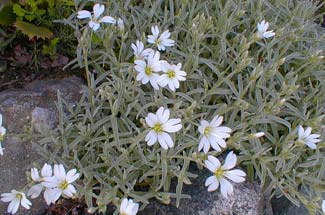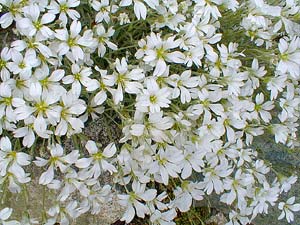
Snow in Summer
Here's a classic rockery plant we never planted. Some while back when we tore out tons of English ivy, we found some evidence that there had once been an elaborate rock garden in that location (as there is again now), but the ivy had completely overwhelmed & smothered everything across a length of time difficult to judge, but likely more than twenty years.
One of the few things that had clung to life under the ivy was the Snow-in-Summer ( Cerastrium tomentosum), though it was most feeble & sun-starved. Although we made no particular effort to save it while discarding the ivy, it nevertheless began to spring up very happily within days of its aggressive foe having disappeared.
 Whenever it appeared in locations where it looked nice, & if it wasn't all mixed in with grasses, then I'd let it remain. It was easily pulled from places it wasn't wanted, & I've never regarded it as a nuisance, though clearly it has an invasive potential. Despite the "summer" tag, it is liveliest April through June, then gets quite scruffy & dies back in July.
Whenever it appeared in locations where it looked nice, & if it wasn't all mixed in with grasses, then I'd let it remain. It was easily pulled from places it wasn't wanted, & I've never regarded it as a nuisance, though clearly it has an invasive potential. Despite the "summer" tag, it is liveliest April through June, then gets quite scruffy & dies back in July.It is almost universally known as Snow-in-Summer, but in some places it is called Mouse-eared Chickweed, after the furry leaves. This name, however, is more commonly applied to the similar but weedier C. vulgatum, despite that the gardened C. tomentosum is actually furier & more mouse-ear-like. C. vulgatum is a Eurasian species that has become very invasive in many areas of Canada & the United States.
Snow-in-Summer has fuzzy silvery foliage with a trailing matting habit that if permitted will become an extensive groundcover, usually only about six inches tall, but it can hump up to a foot. The snowy white flowers begin in April, are at their height of density in May when the flowers can almost hide the leaves, & might or might not still have a few flowers remaining in early July; or such is its schedule on Puget Sound. It will thrive in zones three through ten. Like most pubescent plants it can be quite drought-tolerant, but spreads more rapidly & blooms better with regular watering in well-draining or even sandy soils.
Though heat-tolerant, ours always has a fairly radical die-back in the hottest days of summer, so it might as well be trimmed very short when it is done blooming, since it'll get homely otherwise. Depending on where ours has sprung up, I typically note when it has gone to seed & is on the verge of looking poorly, & just just pull it up & discard it along the roadside where it is welcome to seed itself further.
If I want to be more certain it will reappear in the same location, however, I trim it to the ground rather than pulling it. It shouldn't be sheered at the hottest time of the year, but preferably just before it begins to look scruffy from heat. In a summer-watered location it'll maintain a finer compact appearance if this is done, without blooms. It's roots can be divided either autumn or spring if it seems useful to replant bits of it in selected locations, though I just treat it as though it were a "welcome weed" & let it do as it pleases in the sunny rockery ledges.
Though shortlived, it self-seeds so reliably, it will always have a presence. In containers, cascading down walls or cliff edges, in rockeries & low-maintenance gardens, Snow-in-Summer will do the job. It is native of the mountains of Sicily & Italy, & ranges naturally into western Asia as well, though by now it has naturalized in many other parts of the world.